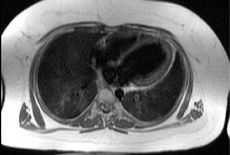Alström syndrome
| Alstrom syndrome | |
|---|---|
 Transaxial image of the chest at the level of the heart illustrating the typical degree of subcutaneous and epicardial adipose tissue (shown in white) in a patient with Alström syndrome; hence the difficulty in imaging by echocardiography. | |
| Classification and external resources | |
| ICD-10 | Q87.8 |
| OMIM | 203800 |
| DiseasesDB | 465 |
| MedlinePlus | 001665 |
Alström syndrome is a rare genetic disorder caused by mutations in the gene ALMS1. It is among the rarest genetic disorders in the world, as currently it has only 266 reported cases in medical literature and over 501 known cases in 47 countries. It was first described by Carl-Henry Alström in Sweden in 1959. Alstrom syndrome is sometimes confused with Bardet-Biedl syndrome, which has similar symptoms. Bardet-Biedl syndrome tends to have later onset in its symptoms.
According to a 2007 article by Joy et al. published in the Orphanet Journal of Rare Diseases:
"Alström syndrome (AS) is a rare autosomal recessive disease characterized by multiorgan dysfunction. The key features are childhood obesity, blindness due to congenital retinal dystrophy, and sensorineural hearing loss. Associated endocrinologic features include hyperinsulinemia, early-onset type 2 diabetes, and hypertriglyceridemia.
Thus, AS shares several features with the common metabolic syndrome, namely obesity, hyperinsulinemia, and hypertriglyceridemia. Mutations in the ALMS1 gene have been found to be causative for AS with a total of 79 disease-causing mutations having been described."[1]
Diagnosis
The Jackson Laboratory in Bar Harbor, Maine, USA with the University of Southampton, UK isolated the single gene (ALMS1) responsible for Alström Syndrome. The gene is recessive; it must be passed from both parents for the syndrome to manifest.
It is possible to clinically detect Alström syndrome in infancy, but more frequently, it is detected much later, as doctors tend to detect symptoms as separate problems. Currently, Alström syndrome is often diagnosed clinically, since genetic testing is costly and only available on a limited basis.
Diagnostic criteria
Marshall JD et al. provided a comprehensive guidance for diagnostic criteria in their 2007 publication.
Birth – 2 years:
Minimum diagnosis requires 2 major criteria or 1 major and 2 minor criteria.
Major criteria are: 1) ALMS1 mutation in 1 allele and/or family history of Alström Syndrome 2) Vision pathology (nystagmus, photophobia).
Minor criteria are: 1) Obesity 2) Dilated cardiomyopathy with congestive heart failure.
Other variable supportive evidence: Recurrent pulmonary infections, normal digits, delayed developmental milestones.
At 3–14 years of age:
2 major criteria or 1 major and 3 minor criteria.
Major criteria are: 1) ALMS1 mutation in 1 allele and/or family history of Alström Syndrome, 2) Vision pathology (nystagmus, photophobia, diminished acuity). If old enough for testing: cone dystrophy by ERG.
Minor Criteria: 1) Obesity and/or insulin resistance and/or Type 2 Diabetes 2) History of dilated cardiomyopathy with congestive heart failure 3) Hearing loss 4) Hepatic dysfunction 5) Renal failure 6) Advanced bone age
Variable supportive evidence: Recurrent pulmonary infections, normal digits, delayed developmental milestones, hyperlipidemia, scoliosis, flat wide feet hypothyroidism, hypertension, recurrent urinary tract infection, growth hormone deficiency.
Presentation 15 years – adulthood:
2 major and 2 minor criteria or 1 major and 4 minor criteria.
Major criteria are: 1) ALMS1 mutation in 1 allele and/or family history of Alström Syndrome. 2) Vision pathology (history of nystagmus in infancy/childhood, legal blindness, cone and rod dystrophy by ERG).
Minor criteria: 1) Obesity and/or insulin resistance and/or Type 2 Diabetes 2) History of dilated cardiomyopathy with congestive heart failure. 3) Hearing loss 4) Hepatic dysfunction 5) Renal failure 6) Short stature 7) Males: hypogonadism, Females: irregular menses and/or hyperandrogenism
Other supportive features: Recurrent pulmonary infections, normal digits, history of developmental delay, hyperlipidemia, scoliosis, flat wide feet, hypothyroidism, hypertension, recurrent urinary tract infections/urinary dysfunction, growth hormone deficiency, alopecia.
Early symptoms
- Heart failure (Dilated cardiomyopathy) in over 60% of cases, usually within the first few weeks after birth, but sometimes the onset is in adolescence or adulthood.[2]
- Light sensitivity and vision problems (Cone-rod dystrophy) in all cases, usually within 15 months of birth and progressively worsening until about 20 years of age[2]
- Developmental delays in 50% of cases, learning disabilities in about 30% of cases
- Obesity in 100% of cases, apparent by 5 years of age, but often apparent in infancy (Alström infants usually have normal birth weights, and by adolescence, weights tend to be in the high-normal to normal range)
Relation to other rare genetic disorders
Recent findings in genetic research have suggested that a large number of genetic disorders, both genetic syndromes and genetic diseases, that were not previously identified in the medical literature as related, may be, in fact, highly related in the genetypical root cause of the widely varying, phenotypically-observed disorders. Thus, Alstrom syndrome is a ciliopathy. Other known ciliopathies include primary ciliary dyskinesia, Bardet-Biedl syndrome, polycystic kidney and liver disease, nephronophthisis, Meckel-Gruber syndrome and some forms of retinal degeneration.[3]
References
- ↑ Joy T, Cao H, Black G, Malik R, Charlton-Menys V, Hegele RA, Durrington PN (2007). "Alstrom syndrome (OMIM 203800): a case report and literature review." (PDF). Orphanet Journal of Rare Diseases 2 (1): 49. doi:10.1186/1750-1172-2-49. PMC 2266715. PMID 18154657.
- ↑ 2.0 2.1 Alström Syndrome
- ↑ Badano, Jose L.; Norimasa Mitsuma; Phil L. Beales; Nicholas Katsanis (September 2006). "The Ciliopathies : An Emerging Class of Human Genetic Disorders". Annual Review of Genomics and Human Genetics 7: 125–148. doi:10.1146/annurev.genom.7.080505.115610. PMID 16722803. Retrieved 2008-06-15.
External links
- GeneReviews/NCBI/NIH/UW entry on Alstrom syndrome
- OMIM entries on Alström syndrome
- Alström Syndrome International home page
- The UK Alström Syndrome Support Group Home page
- Alström syndrome in the Swedish Rare Disease Database
- Alstrom Syndrome. Eur J Hu Genet (Practical Genetics): 15, 2007, S. 1193–1202
| ||||||||||||||||||||||||||||